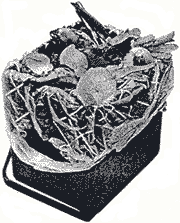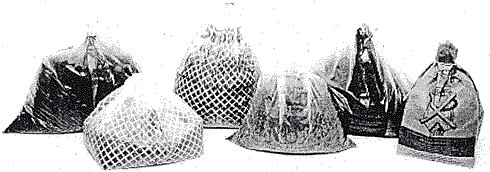|
Bionedbrydelige plastposer til indsamling af den organiske del af dagrenovationen til biogasanlæg Bilag I:
|
| Do the bags fulfil present evaluation standards of compostability? |
| How quickly do the bags decompose at professional composting facilities or in private or communal compost facilities? |
| What is the influence on processing in the composting facilities? |
| Is the quality of the compost impaired? |
| Do the bags prove themselves in household use or what are the advantages and disadvantages for the consumer? . |
| What are the changes for garbage collectors? |
| Do the bags prompt organic-waste, disposal of foreign matter? |
| How great is the environmental stress due to BDM bags as opposed to that which is due to conventional collection methods (green bucket, containers with and without inlets)? |
3.2 Results from the Tests:
Consumers: It has been established that there is a demand on the part of the consumer for BDM bags for organic-waste collection. When questioned, one half to two thirds of households expressed a willingness to buy such bags. Positive adjectives used to describe them were: clean, practical, hygienic, compostable. Negative adjectives were: leaky, costly.
Private composting: Most of the BDM bags examined in the test for organic waste have proved themselves in private use. They involve little additional care in compost management and decompose within the usual decomposition period. Two thirds of the compost groups questioned would, allow the use of BDM bags on their compost heaps, one third would not.
Community collection: During the test period, organic-waste collection with BDM bags did not lead to. an increase in foreign matter (Tab. 1). This fact was confirmed after one year of experiences in Lucerne - a town of 60'000 inhabitants.
Tab. 1:
Foreign matter in organic-waste collection with BDM bags and without
(reference) (*: above guidelines [2]).
|
plane plastics |
foreign matter >2mm |
stones >5mm |
reference |
1.06 % * |
1.59 % * |
0.05% |
BDM-bags |
0.17 % * |
0.80 %* |
0.04 |
BDM bags were greeted with approval by garbage collectors, who said that they made the
collection of organic waste quicker, easier and more hygienic.
For use in organic-waste collection, the bags would have to be made more user-friendly with regard to stability, recognizability and transparency.
Professional composting facilities: In communal composting facilities, BDM bags (PCL, Mater-Bi) decomposed within the usual decomposition period. The operators failed to detect any impairment of the decomposition process:
An increase in the amount of care taken to sort out foreign matter must be expected. As to compost quality in composting BDM bags, the quality achieved the usual target level.
Laboratory tests: Bags made out of PCL (Polycaprolacton) and TPS (Thermoplastic Starch) fulfilled the decomposition specifications (mineralization and laboratory composting) according to DIN draft 54,900 [3]. Because of their longer decomposition period and their unfitness for external analysis for foreign matter, bags made out of Kraft paper can be used in private compost heaps but not in organic-waste collection, in professional composting facilities and not in the compost.. heaps of housing estates.
The heavy-metal analysis of the foils show that- no paints containing copper (blue, green) should be used; otherwise, the limit for heavy metals as set forth in DIN draft 54,900 is exceeded.
Ecoprofile: The ecoprofile of collecting organic waste in the kitchen is best when a bucket without an inlet (BDM bag) is used and the bucket is rinsed with cold water. The use of BDM bags as inlets is demonstrably less ecologically damaging than if the bucket is washed with hot water and possibly with a detergent, as is the case today in more than 70% of Swiss households (Fig. 2).
The use of inlets in containers presents no more stress to the environment than the presently accepted method of cleaning with cold water.

Fig. 2:
Ecoprofile of collecting organic.waste in' buckets with BDM bags (3 products)
and PE bags as inlets and without inlet (including rinsing) after CML-Model [4], Eco-Indicator `95 [5], UBP [6] normed to the highest impact.
A further LCA-study of Mater-Bi bags compared with paper bags and PE bags used for the collection of organic waste in households realised according to ISO 14040 incl. external critical review confirmed the results from the above mentioned study [7].
3.3 Test Conclusions
The use of BDM bags in organic-waste collection is to be recommended, provided the following:
| The BDM bags must be transparent enough for spot-checking for foreign matter. Paper bags are not suitable to control the content during the organic waste collection due to opacity. |
| No heavy-metal-containing dyes may be used. In this respect, the tested product must be further developed. |
| The bags must be strong enough for household use during a period of at least one week and the subsequent collection by hand from the sidewalk. In this respect, the tested products must be further developed. |
| BDM bags must feature a biodegradable closing mechanism so as to, prevent the use of nondegradable string. |
| The BDM bags must pass compostability tests according to an international norm, i.e. DIN draft 54,900. |
| BDM bags must be marked clearly and uniformly possible for retailers, consumers, garbage collectors and composting supervisors in order that they can distinguish them from ordinary plastic garbage bags. |
The results of the tests and the conclusions are published in detail in a comprehensive report in German [8] and in short reports in French [9] and English [10].
4. Project Group
Based on the results of these tests and under a mandate of the Swiss Agency of Environment, Forest and Landscape (SAEFL), the test supervisors instituted a project group including representatives from manufacturing companies, retailers, cities, processing plants and specialized authorities. The aim was to achieve mutually acceptable solutions for the existing, exigencies.
The following solutions were found after three meetings within half a year. The guidelines for all BDM bags sold in Switzerland.,
1. The BDM bags have to fulfil the requirements of the DIN draft. 54'900, and they must be registered at DIN CERTCO. These bags/materials are all to bear the label of DIN CERTCO exclusively (Fig. 2)

Fig 3:
Label of DIN CERTCO that mark the compostable materials/products which fulfil
the requirements of DIN draft 54900.
2. The BDM bags must be marked uniformly with a white grid to be distinguishable from bags made out of conventional plastics. Only bags registered at DIN CERTCO are allowed to bear the white grid.
3. Determined public relations on the subject of the BDM bags was made in collaboration of all concerned branches.
| A flyer as enclosure in the bags package sold at the wholesaler informs the consumer of the use and disposal, the advantages and limits of the BDM-bags. |
| Advertisments made the pros of the BDM-bags public. |
| Articles in newspapers and special periodicals content the facts and figures specific to their readers. |
| Representatives of communities and managing director of composting facilities were invited to meetings in Biel and Zug. Beside lectures on biodegradable materials and experiences from the tests and in practice the program included round table discussions involving all participants. |

Fig. 4:
Biodegradable bags in the daily use.
In order to improve the organic waste collection some communities promoted the BDM -bags beside a limited assortment of waste containers. These changes were published in flyers distributed to all households.
5. State of the Art 2000
Today only tested and uniformly marked bags are sold in Switzerland. The white grid proved itself s ability in the organic waste collection and in the composting facilities. The marked bags are easy to be distinguished from conventional plastic bags.
Migros, the biggest wholesaler of Switzerland integrated the.BDM bags into its basic assortment, and they have been sold in all shops since May 1999. The sales are satisfying and exceeded the expectations.
There is a high demand for small BDM bags used as inlets for the compost' buckets in the households. The number of BDM bags for big containers (more than 120 litres) is increasing. The bags should be improved with regard to stability. As the decomposition starts with the first contact with organic material and is accelerated by humidity and heat, some of the bags tear already in households or during the collection.
In an increasing number of communities the BDM bag is accepted in the organic waste collection as complementary to the existing collection logistics. A few communities use the BDM bags for their taxable organic waste collection: the tax for the collection is included in the price of the bag.
The fears of some processing facilities about increasing foreign matter, insufficient biodegradability and distribution by wind did not prove in practice. Therefore an increasing number of composting facilities is accepting and processing organic-waste including BDM bags.
However, a of communication work is necessary for individual consulting of communities and processing facilities: due to the small and self-employed units (3000 communities, 250 processing facilities). The federations of the communities as well as of the facilities are not effective enough to work as information centres.
Some processing facilities in the region of Zurich make interference in the BDM bag discussion using arguments without any proved fact.
6. The Future
The experiences of the BDM bag introduction is useful for promoting other biodegradable products such as packaging of fruits and vegetables, flower pots and other gardening means. These products designed to be recycled in composting facilities have to fulfil the following requirements:
| to guarantee biodegradation according to an international norm incl. certification. |
| uniform mark to distinguish them from conventional plastic products |
| offensive communication to inform all concerned partners in the circle of the products life. |
The biodegradable products partly made out of renewable resources are processed in composting facilities. The compost serves as fertiliser for the renewable resources. BDM products promote the business of all participants: farmers, converters, retailers, consumers and processors - they live in the circle of nature.
References
| [1] | BUWAL (1998): Abfallstatistik 1998. Umweltmaterialien Nr. 90,
BUWAL, Bern |
| [2] | FAC (1995): Kompost und Klärschlamm, Weisungen and
Empfehlungen der Eidg. Forschungsanstalt für Agrikulturchernie und Umwelthygiene (FAQ im
Bereich Abfalldünger. Eidg. Drucksachen and Materialzentrale, Bern |
| [3] | DIN draft 54,900 (1997): Testing of the compostability of
polymeric materials. Beuth-Verlag, Berlin |
| [4] | Heijungs, R., Guinee, J.B., Huppes, G., Lankreijer, R.M., Udo
de Haes, H.A. & Wegener Sleeswijk, A. (1992): Environmental Live Cycle Assessment of
Products, Guide and Backgrounds, R. Heijungs (Editor), CML Leiden |
| [5] | Goedkoop, M. (1995): The Ego-indicator 95, Amersfoort 1995 |
| [6] | BUWAL (1990): Methodik für Oekobilanzen auf der Basis der
ökologischen Optimierung. Schriftenreihe Umwelt Nr. 133, BUWAL, Bern |
| [7] | Composto, 1998: Life cycle assessments of Mater-Bi bags for
the collection of compostable waste. Novamont SpA, Novara |
| [8] | Kompostforum Schweiz, Stiftung für Konsumentenschutz, EMPA,
1998: Test von Säcken aus biologisch abbaubaren Werkstoffen für die Grüngutsammlung.
Composto, Olten. |
| [9] | Kompostforum Schweiz, Stiftung für Konsumentenschutz, EMPA,
1998: Tests des sacs biodegradable pour la collecte des déchets verts. Composto, Olten |
| [10] | Kompostforum Schweiz; Stiftung fir Konsumentenschutz, EMPA, 1998: Tests of biodegradable bags for organic waste collection. Composto, Olten |
